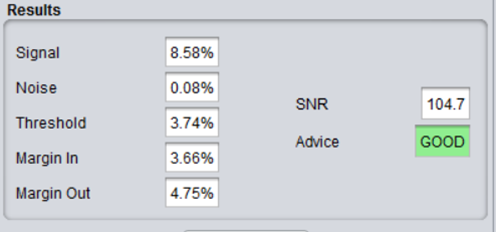SLAA843A August 2018 – March 2019 MSP430FR2512 , MSP430FR2512 , MSP430FR2522 , MSP430FR2522 , MSP430FR2532 , MSP430FR2532 , MSP430FR2533 , MSP430FR2533 , MSP430FR2632 , MSP430FR2632 , MSP430FR2633 , MSP430FR2633
3 Terminology
This section defines and explains the key terms that are needed to perform a more detailed assessment of reliability and robustness.
 Figure 4. Results
Figure 4. Results
- Signal (S)
- Noise (N)
- Threshold (Th)
- Margin In (Min)
- Margin Out (Mout)
- SNR (Signal-to-noise ratio)
- Advice
NOTE
Percent Change in Capacitance: The unit of choice for analyzing capacitive touch SNR and design margin is percent change in capacitance. Capacitive touch sensing is based on measuring relative changes over time in an existing, but unknown, electrode capacitance. As such, it is most straightforward to work in terms of percent change. Another benefit of this perspective is that it removes any dependencies on the conversion settings. Filtered count and LTA values can vary with conversion settings and other factors, but percent change in capacitance is a function of the electrical hardware (the PCB) and the mechanical hardware (the overlay material). As such, percent change in capacitance is used for all parameters with the exception of ratios (such as SNR). Percent change in capacitance can be easily computed for a given filtered count, LTA, and conversion gain value using the relationship in Equation 1.